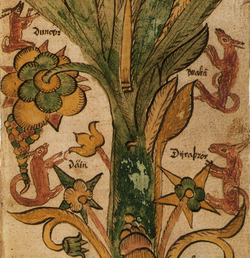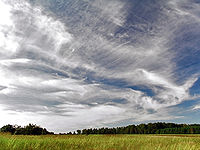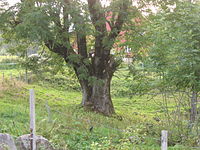- Dáinn, Dvalinn, Duneyrr and Duraþrór
-
 This drawing made by a 17th century Icelander shows the four stags on the World Tree. Neither deer nor ash trees are native to Iceland.
This drawing made by a 17th century Icelander shows the four stags on the World Tree. Neither deer nor ash trees are native to Iceland.
In Norse mythology, four stags or harts (male Red Deer) eat among the branches of the World Tree Yggdrasill. According to the Poetic Edda, the stags crane their necks upward to chomp at the branches. Their names are given as Dáinn, Dvalinn, Duneyrr and Duraþrór. An amount of speculation exists regarding the deer and their potential symbolic value.
Contents
Primary sources
The poem Grímnismál, a part of the Poetic Edda, is the only extant piece of Old Norse poetry to mention the stags.
- Grímnismál 33
- Hirtir ero ok fiórir,
- þeirs af hæfingar á
- gaghálsir gnaga:
- Dáinn ok Dvalinn,
- Dúneyrr ok Duraþrór.[1]
- Hollander's translation
- Four harts also
- the highest shoots
- ay gnaw from beneath:
- Dáin and Dvalin,
- Duneyr and Dýrathrór.[3]
The second line is enigmatic. The word á is hard to explain in context and sometimes omitted from editions. The word hæfingar is of uncertain meaning. Finnur Jónsson conjecturally translated it as "shoots".[4] English translators have translated it as "the highest shoots" (Hollander),[5] "summits" (Thorpe), "the highest twigs" (Bellows),[6], "the high boughs" (Taylor and Auden)[7] and "the highest boughs" (Larrington).[8]
This verse of Grímnismál is preserved in two medieval manuscripts, Codex Regius (R) and AM 748 I 4to (A). The text and translations above mostly follow R, the older manuscript. Where R has the word hæfingar, A has the equally enigmatic hæfingiar. Where R has gnaga ("gnaw"), A has ganga ("walk"), usually regarded as an error. A third difference is that R has "ágaghálsir" in one word where A clearly has "á gaghálsir" in two words. In this case the A reading is usually accepted.[9][10][11]
In the Gylfaginning part of Snorri Sturluson's Prose Edda the stanza from Grímnismál is summarized.
- Gylfaginning 16
- En fjórir hirtir renna í limum asksins ok bíta barr, þeir heita svá: Dáinn, Dvalinn, Duneyrr, Duraþrór.[12]
- Brodeur's translation
- [A]nd four harts run in the limbs of the Ash and bite the leaves. They are called thus: Dáinn, Dvalinn, Duneyrr, Durathrór.[13]
- Byock's translation
Four stags called Dain, Dvalin, Duneyr and Durathror move about in the branches of the ash, devouring the tree's foliage.[14]
The word barr has been the cause of some confusion since it is most often applied to the needles of fir or pine trees. Richard Cleasby and Guðbrandur Vigfússon surmised that Snorri had used the word wrongly due to Icelandic unfamiliarity with trees.[15] Others have drawn the conclusion that the World Tree was in fact a conifer. More recent opinion is that barr means foliage in general and that the conifer assumption is not warranted.[16]
Theories
 Sky as branches of Yggdrasill: compare how patterns of cirrus clouds may resemble branches of an ash tree
Sky as branches of Yggdrasill: compare how patterns of cirrus clouds may resemble branches of an ash tree
Early suggestions for interpretations of the stags included connecting them with the four elements, the four seasons or the phases of the moon.
In his influential 1824 work, Finnur Magnússon suggested that the stags represented winds. Based on an interpretation of their names, he took Dáinn ('The Dead One') and Dvalinn ('The Unconscious One') to be calm winds and Duneyrr and Duraþrór to be heavy winds. The stags biting the leaves of the tree, he interpreted as winds tearing at clouds. The fact that Dáinn and Dvalinn are also dwarf names, he connected with dwarves having control of winds.[17]
Many scholars, following Sophus Bugge, believe that stanzas 33 and 34 of Grímnismál are of a later origin than those surrounding them.[18][19] Finnur Jónsson surmised that there was originally only one stag which had later been turned into four, probably one on each side.[20] This is consistent with stanza 35 of Grímnismál, which mentions only one hart:
- Grímnismál 35
- Askr Yggdrasils
- drýgir erfiði
- meira enn menn viti:
- hiörtr bitr ofan,
- en á hliðo fúnar,
- skerðer Níðhöggr neðan.
- Thorpe's translation
- Yggdrasil’s ash
- hardship suffers
- greater than men know of;
- a hart bites it above,
- and in its side it rots,
- Nidhögg beneath tears it.
It has been suggested that this original stag is identical with Eikþyrnir, mentioned earlier in Grímnismál.[21]
See also
Notes
- ^ Norse text, Ed. Helgason
- ^ Trans. Thorpe
- ^ Hollander, p. 60.
- ^ "hœfingar: brumknappar (merkíng óviss)", Finnur Jónsson 1905, p. 492.
- ^ "Conjecturally", Hollander, p. 60.
- ^ "Highest twigs: a guess; the Mss. words are baffling. Something has apparently been lost from lines 3-4, but there is no clue as to its nature", Bellows, p. 98.
- ^ Here quoted from http://home.earthlink.net/~wodensharrow/grimnismal.html
- ^ Larrington, p. 56.
- ^ "þeirs af hæfingar / gaghalsir gnaga", Finnur Jónsson 1905, p. 81.
- ^ Lüning, p. 176.
- ^ Munch, pp. 30 & 192.
- ^ Ed. Björnsson
- ^ Trans. Brodeur
- ^ Byock, p. 27.
- ^ Cleasby/Vigfusson, page b0053
- ^ "Together, bíta barr means to eat the foliage off a tree, words suitable for both an ash tree and a pine", Byock, p. 140.
- ^ "Efter Hjortenes Navne at dömme betegne Dáin og Dvalin (de sövndyssende, rolige) den milde og blide Vind; Dyneyrr (den dönelskende, dundrende) og Dyrathror (den dörstærke; som opsprænger Döre) derimod de heftige og stormende. Da Dvergene og raade for Vindene, have de to förste Hjorte fælles Navne med tvende af dem. Nogle forklare disse Hjorte for de 4 Elementer, eller og de 4 Aarstider, Maanens Phaser m. m.", Finn Magnusen, p. 144.
- ^ "Stanzas 33-34 may well be interpolated, and are certainly in bad shape in the Mss. Bugge points out that they are probably of later origin than those surrounding them", Bellows, p. 98.
- ^ "The following two stanzas are very likely interpolations", Hollander, p. 60.
- ^ "Síðari hugmyndir eru það, að hjörturinn verður að 4 hjörtum, líklega einn við hverja hlið", Finnur Jónsson 1913, p. 22.
- ^ "[N]othing further is known of the four harts. It may be guessed, however, that they are a late multiplication of the single hart mentioned in stanza 26", Bellows, p. 98.
References
- Brodeur, Arthur Gilchrist (transl.) (1916). The Prose Edda by Snorri Sturluson. New York: The American-Scandinavian Foundation.
- Byock, Jesse (tr.) (2005). Snorri Sturluson: The Prose Edda. Penguin. ISBN 0-140-44755-5.
- Eysteinn Björnsson (ed.). Snorra-Edda: Formáli & Gylfaginning : Textar fjögurra meginhandrita. 2005. http://www.hi.is/~eybjorn/gg/
- Finn Magnusen (1824). Eddalæren og dens Oprindelse Gyldendal: Kjöbenhavn. Available at Google Books at http://books.google.com/books?id=MScOAAAAYAAJ
- Finnur Jónsson (ed.) (1905). Sæmundar-Edda : Eddukvæði. Reykjavík.
- Finnur Jónsson (1913). Goðafræði Norðmanna og Íslendinga : Eftir heimildum. Reykjavík: Hið íslenska bókmentafjelag.
- Hollander, Lee M. (1962). The Poetic Edda. Austin: University of Texas. ISBN 0-292-76499-5.
- Jón Helgason (ed.) (1955). Eddadigte (3 vols). København: Munksgaard. Text of Grímnismál available online at http://www.snerpa.is/net/kvaedi/grimnir.htm
- Larrington, Carolyne (transl.) (1996). The Poetic Edda. Oxford World's Classics. ISBN 0-19-283946-2.
- Lüning, Hermann (ed.) (1859). Die Edda. Zürich.
- Munch, P. A. (ed.) (1847). Den ældre Edda. Christiania.
- Thorpe, Benjamin (tr.) (1866). Edda Sæmundar Hinns Froða : The Edda Of Sæmund The Learned. (2 vols.) London: Trübner & Co.
The cosmological tree Yggdrasil and its inhabitants in Norse mythology Inhabitants Dáinn, Dvalinn, Duneyrr and Duraþrór (highest boughs) · Ratatoskr (travels up and down) · Veðrfölnir and eagle (top)
Roots reaching to Hvergelmir · Níðhöggr and numerous serpentsFrost JötnarSee also Hoddmímis holt · Læraðr · Mímameiðr · Sacred tree at Uppsala · Category:Trees in Germanic paganism · Norse cosmologyCategories:- Creatures in Norse mythology
- Mythological deer
Wikimedia Foundation. 2010.

